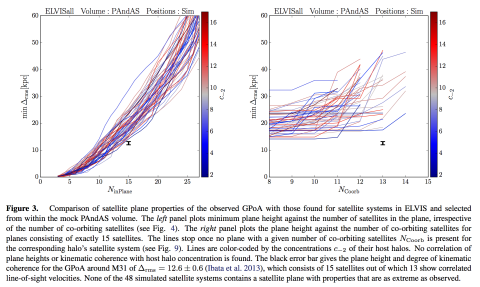My newest paper, recently accepted for publication in ApJ, is now available as a preprint on the arXiv: Do halos that form early, have high concentration, are part of a pair, or contain a central galaxy potential host more pronounced planes of satellite galaxies?
Planes of satellite galaxies are a problem for the standard model of cosmology, because structures as extreme as those observed around the Milky Way, the Andromeda galaxy, and Centaurus A are very rare in cosmological simulations. A possible solution is that some host halos with special properties or unique environments are more likely to host such extreme structures, an idea wich would then even allow us to learn about the host dark matter halos and their history from the fact that they are surrounded by a satellite plane. Buck et al. (2015) had proposed that there is such a correlation between satellite planes and the concentration parameter of the host dark matter halo (as a proxy of its formation time).
 In my new paper, we have tested this claim with a larger set of simulated hosts, a more careful satellite selection, and using different methods to look for a correlation. No such correlation with halo concentration or formation time is present, nor do any of the simulated systems reproduce the observed narrow planes and their kinematic correlation (see plot, black symbol gives the observed value). The only correlations found have to do with the radial extent of the satellite system, a well known effect that was not sufficiently considered in the earlier study. We have also tested for environmental effects, and find that being situated in a paired configuration (like the Milky Way and Andromeda) does not help solve the satellite plane issue. Finally, we also looked at the dominant effect baryonic physics has on the distribution of satellite galaxies in a halo: the influence of having a central disk galaxy potential that results in additional tidal disruption compared to a pure dark-matter-only simulation. It turns out that this makes the issue worse, because the planes found in the presence of a central potential are on average wider than in equivalent simulations without such a potential. This indicates that, in contrast to many other small-scale issues of LCDM, the Planes of Satellite Galaxies problem is made worse when including baryonic effects.
In my new paper, we have tested this claim with a larger set of simulated hosts, a more careful satellite selection, and using different methods to look for a correlation. No such correlation with halo concentration or formation time is present, nor do any of the simulated systems reproduce the observed narrow planes and their kinematic correlation (see plot, black symbol gives the observed value). The only correlations found have to do with the radial extent of the satellite system, a well known effect that was not sufficiently considered in the earlier study. We have also tested for environmental effects, and find that being situated in a paired configuration (like the Milky Way and Andromeda) does not help solve the satellite plane issue. Finally, we also looked at the dominant effect baryonic physics has on the distribution of satellite galaxies in a halo: the influence of having a central disk galaxy potential that results in additional tidal disruption compared to a pure dark-matter-only simulation. It turns out that this makes the issue worse, because the planes found in the presence of a central potential are on average wider than in equivalent simulations without such a potential. This indicates that, in contrast to many other small-scale issues of LCDM, the Planes of Satellite Galaxies problem is made worse when including baryonic effects.
For more explanations, read the paper of have a look at my corresponding Twitter thread.
